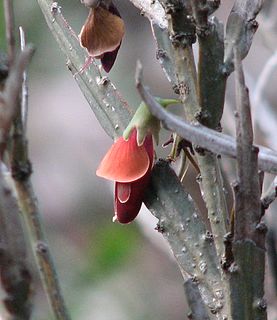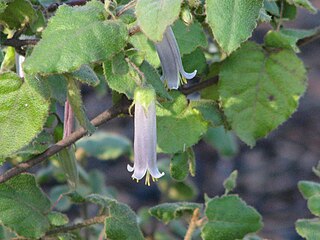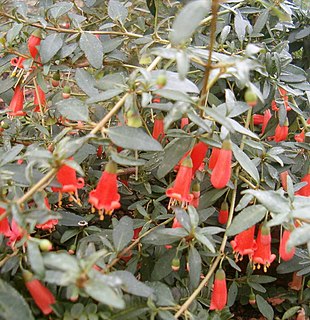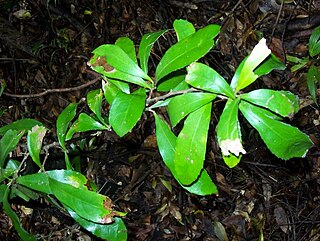
Correa is a genus of flowering plants in the family Rutaceae, with bell-shaped flowers, native mainly to eastern Australia. There are ca. 11 species in the genus and 26 subspecies. Natural hybridisation between the species makes taxonomic relationships within this genus problematic. There are also hundreds of named cultivars, many of which have been registered with the Australian Cultivar Registration Authority.

Casuarina is a genus of 17 tree species in the family Casuarinaceae, native to Australia, the Indian subcontinent, southeast Asia, islands of the western Pacific Ocean, and eastern Africa. It was once treated as the sole genus in the family, but has been split into four genera.

Hakea is a genus of about 150 species of plants in the Family Proteaceae and are endemic to Australia. They are shrubs or small trees with leaves that are sometimes flat, otherwise circular in cross section in which case they are sometimes divided. The flowers are usually arranged in groups in leaf axils and resemble those of other genera, especially Grevillea. Hakeas have woody fruit which distinguishes them from grevilleas which have non-woody fruit which release the seeds as they mature. Hakeas are found in every state of Australia with the highest species diversity being found in the south west of Western Australia.

Homoranthus is a genus of about thirty species of plants in the myrtle family Myrtaceae and all are endemic to Australia. Plants in this genus share similarities with those in both Darwinia and Verticordia. They are shrubs with their leaves arranged in opposite pairs and with flowers appearing either singly or in small groups, usually in upper leaf axils. They are found in Queensland, New South Wales and South Australia. The genus was first described in 1836. None of the species is common nor are they well-known in horticulture.
Castanospora is a monotypic genus of trees, constituting part of the plant family Sapindaceae. The sole species Castanospora alphandii, commonly known as brown tamarind, grows naturally in the Australian rainforests of north-eastern New South Wales and eastern Queensland as far north as the Wet Tropics rainforests of north-eastern Queensland.

Hakea orthorrhyncha, commonly known as bird beak hakea, is a shrub which is endemic to the Murchison River area of Western Australia.

Bossiaea is a genus in the pea family (Fabaceae) consisting of about 70 species which are native to Australia. The genus is named in honour of Joseph Hugues Boissieu La Martinière, a botanist on La Pérouse's expedition to Australia.

Correa reflexa, commonly known as common correa or native fuchsia, is a shrub which is endemic to Australia.

Correa baeuerlenii is a shrub which is endemic to New South Wales in Australia. It is commonly known as chef's-hat correa due to the shape of its greenish-yellow flowers. It grows to between 1 and 2.5 metres in height, and has ovate to elliptic leaves which have a shiny, green upper surface.

Correa lawrenceana, commonly known as mountain correa, is a shrub or small tree of the family Rutaceae that is endemic to Australia.

Eucalyptus oleosa, commonly known as the red mallee, glossy-leaved red mallee, acorn mallee, oil mallee or giant mallee, is a tree or mallee that is native to Australia. The leaves were once harvested for the production of cineole based eucalyptus oil. Eucalyptus cneorifolia is now the predominant strain used in production due to a higher oil content in new growth.

Grevillea hookeriana is a shrub species in the family Proteaceae. It is endemic to the south west region of Western Australia.

Richea is a genus of 11 species of flowering plants in the family Ericaceae. Nine of the species are endemic to Tasmania and the other two are endemic to the south-east of the Australian mainland.

Correa aemula, the hairy correa, is a shrub which is endemic to Australia. It grows up to 2 metres in height. The elliptic leaves are densely hairy and are up to 7 cm long and 3 cm wide. The pendent, tubular flowers are mainly produced between September and December in the species' native range. These are yellow or pale blue-green in colour.

Correa pulchella, the salmon correa or Australian fuchsia, is a species of flowering plant in the family Rutaceae. It is small evergreen shrub, endemic to South Australia. It grows to 0.3–1 m in height and 1–2 m in width. The leaves are linear-oblong to broadly ovate. The pendent, tubular flowers appear between April and September in the species' native range. These are pink-red, orange, or rarely white, and have yellow anthers.

Hicksbeachia pinnatifolia is a small tree in the family Proteaceae. This rare species is native to subtropical rainforest in New South Wales and Queensland in Australia. Common names include red bopple nut, monkey nut, red nut, beef nut, rose nut and ivory silky oak. The tree produces fleshy, red fruits during spring and summer. These contain edible seeds.

Helicia glabriflora is a species of rainforest shrubs or small trees occurring in eastern Australia. Common names include smooth or pale helicia, pale, leather or brown oak. They grow naturally in a variety of different rainforest types from the Illawarra, New South Wales to the Townsville area, Queensland . Of all the global diversity of approximately one hundred Helicia species, this one species naturally grows the furthest south, in the Minnamurra Rainforest and the Robertson area, Illawarra, New South Wales, there observed more on the relatively fertile basalt and alluvial soils.

Adenanthos detmoldii, commonly known as Scott River jugflower or yellow jugflower, is a species of shrub in the family Proteaceae. It is endemic to the south-west of Western Australia.
Grevillea stenobotrya is a shrub in the family Proteaceae. It is endemic to arid regions of Australia. Common names include rattle-pod grevillea, sandhill grevillea and sandhill spider flower. Plants grow to between 1.5 and 6 metres in height and have leaves are linear and entire, or occasionally divided, and between 6 and 28 cm long and 0.7 to 2.5 mm wide. Flowers are cream, pale yellow or pale pink. These appear in clustered spikes at the end of branches between May and December in the species' native range. The fruits which follow are hard, flattened and rounded and have a short beak.
Hollandaea is a genus of four species known to science, of Australian rainforest trees, constituting part of the plant family Proteaceae.
















